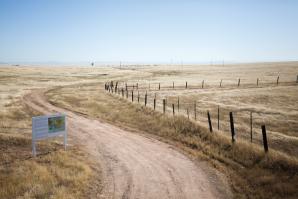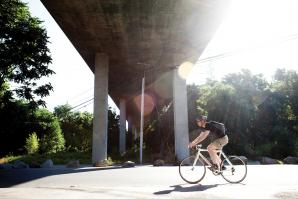In October 2007, 60-year-old Francisco “Willie” Lopez was doing what he had done almost every morning for 30 years. He pedaled along County Road 99 from Woodland to his job in the finance department at UC Davis. A car hit and killed him on that country road before he made it to his desk.
That incident shined a spotlight on slow-moving plans to create a bike path between the two cities. In the two years since, parts of CR 99 have been widened, but Paul Pfotenhauer, a producer at UC Davis News Service, says that is not enough. The Woodland resident has been commuting to his job in Davis for 30 years. He rode his bike for three of those, but had a number of close calls and switched to public transportation. “There is no protection when cars are whizzing by,” Pfotenhauer says. “You are always looking over your shoulder.”
Pfotenhauer would like to see a dedicated, paved bike path, and the Davis-Woodland Bikeway Feasibility Study suggests a lot of people agree with him. Bicycle commuting already represents almost 25 percent of overall commute trips in Davis — one of the highest percentages in the country.
According to estimates by the Sacramento Area Bicycle Advocates, hundreds of cyclists take to the county roads each week in Yolo County. UC Davis estimates 200 students and about 1,000 faculty and staff live in Woodland and commute to UC Davis. Fehr & Peers Transportation Consultants concludes “a well-connected and well-designed alternative transportation corridor could result in an increase in bicycle mode share of up to 5 percent.”
A similar study in 2001, funded by the cities of Davis and Woodland, Yolo County and the Yolo-Solano Air Quality Management District looked at six alternatives to link the two cities.
Lopez’ accident, along with encouragement from the state and federal government to reduce greenhouse gasses, and the adoption of a Woodland-Davis bike path as a high priority by the county in its 2008 Strategic Plan, kicked the planning process into a higher gear.
The current incarnation of the alternative vehicle plan also looks at the possibility of including a dedicated Neighborhood Electric Vehicles lane similar to the one implemented in Lincoln and Rancho Mission Viejo.
Bennett Engineering Services studied three possible alignments for the approximately six-mile trek. One roughly follows State Route 113 on County Road 99 and East Street in Woodland; another parallels the railroad tracks from Covell Road to East Street or the same route to Willow Slough.
The price tag could run between $10 million and $14 million depending on the alternative chosen, says Roxanne Namazi, the city of Davis representative for the study. Planners hope to win state and federal grants for the majority of the construction costs.
Pfotenhauer suggests users might be willing to pay user fees for maintenance. He currently pays $70 a month for the Yolo Bus. “I would pay $30 a month for weekly maintenance,” Pfotenhauer says.
This fall various commissions, city councils and boards of supervisors are providing input for the plan. This information helps planners come up with preferred alternatives based on rights-of-way, construction and maintenance costs, accessibility, environmental and agricultural impacts and aesthetic value.
Then design can begin, but the plan is still four to five years off before construction can begin. “It all depends on federal funding sources,” says Christopher Fong, associate civil engineer with the city of Woodland.
Concerns being addressed in the study include security to combat vandalism to adjacent agricultural and railroad property. Other cities have used fencing and volunteer patrols, but a lot could depend on the route and the popularity of the trail.
“Security is an issue because the route is potentially a long way away from nowhere,” Fong says.
– J.T. Long
Recommended For You

Neighborhood Watch
A planned development near Rancho Cordova is sparking intense debate
Infill or outpost? Sprawl or smart planning? How some people view the Cordova Hills development proposed for southern Sacramento County may depend on which end of Highway 50 they’re looking from.

Spinning Wheels
Funding limitations, competing priorities stall bikeway development
As chief executive officer of the Sacramento Area Council of Governments (SACOG), McKeever oversees planning and funding processes for cycling transportation projects, so he’s interested in what works and what doesn’t.



